Alaska Fish & Wildlife News
April 2024
Ode to the Clever Black-Capped Chickadee
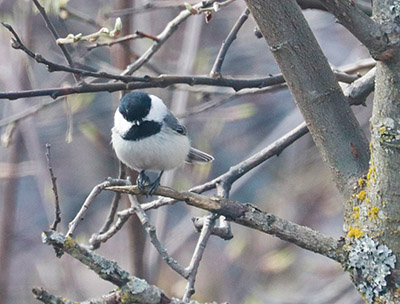
I think it’s just about impossible not to hear a chickadee call and call back “chicka-dee-dee-dee”.
Their rising and falling “fee-bee” call is also familiar on the cold days.
In that time of year before we put our bird feeders away, my son and I would sit on the porch and, very quietly, let them grow accustomed to our presence, just so we could watch them. They were charming to observe, flinging sunflower seed husks with enthusiasm, squabbling and chattering at newcomers to the feeder. They are what my now 10-year-old classifies as a “borb”: a bird and an orb at once, with rotund heads, and proportionately small bodies. I would imagine you, the reader, know them well. They’re easily identifiable for their namesake, a black cap and “mask” over their eyes. White horizontal stripes run from their short, stubby beaks to the backs of their heads. They have a distinct black bib over a buff-colored chest. Their backs and wings are grey with white edges. Most wonderfully of all, they are bold and inquisitive little birds.
Black-capped Chickadees, or Poecile atricapillus, are among our most common bird feeder visitors, alongside dark-eyed juncos and song sparrows. Common, however, doesn’t mean unremarkable; sometimes, it’s well worth taking a look at what we see the most, because often our most delightful surprises are hiding in plain sight.
Everything in Alaska is made bigger. Our chickadees are no exception; they’re nearly 25% bigger than their counterparts down south. Generally, they weigh around a half-ounce, so the equivalent of a tablespoon of butter. They measure about four-and-a-half to six inches (12-15 cm) in length, with a wingspan of six to eight inches (16-21 cm). They’re a little heftier in the winter months, as they fatten up on rich oils and foods leading into the long, cold season, storing that body fat to sustain them when food is scarce. Enduring and resilient, these fantastic little survivors are well-adapted to brave the cold.
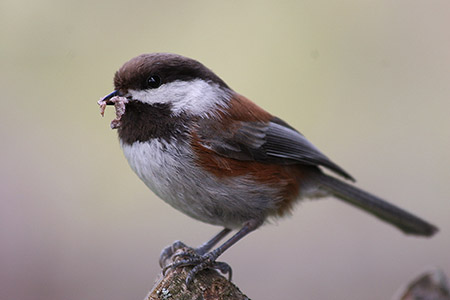
Their survival also hinges on other strategies. Their bodies are able to enact a mechanism called nocturnal hypothermia, which drops a bird’s body temperature by more than 50 degrees fahrenheit, (a change of about 30 degrees celsius). This allows them to consume less energy, conserving those fat storages for when they really need it. They will find refuge in cavities of trees at night to weather freezing temperatures. Their denser plumage enables them to puff up to afford them additional warmth.
They have one more fabulous tool for their winter survival.
Cache Me If You Can
Black-capped Chickadees, under the fluff and the plumage and button-cuteness, have incredible memory. Black-capped chickadees engage in caching behavior, which is to say, they tuck their food away in hiding places, just like squirrels do. The Aranov Lab at the Zuckerman Mind Brain Behavior Institute at Columbia University conducted tests in 2023 to understand the why and the how of this behaviour in these curious little birds. The act of caching is dependent on episodic memory – meaning that the bird must hold a memory exactly when they’re hiding their food. Episodic memory is where we recall a specific experience from the past.
Have you ever put down your keys or wallet when you’re not paying attention, and find that you’re unable to recall where you put it? When we are conscientious about when we do so, we’re holding a memory of where we put that object down. Chickadees must do this in order to remember where they’ve stashed their food away, and must know the specific details of that hiding place. It’s one thing to remember locking the door; it’s another thing altogether to know the details of the root pattern of a tree and where the tree sits in relation to its neighbors. Now rinse and repeat for up to 5,000 times a day: that’s a day in the life of an industrious Chickadee.
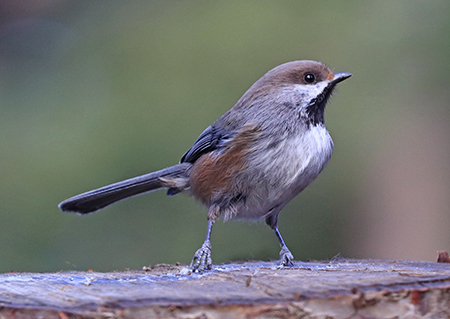
We form our episodic memories in the hippocampus. It’s centrally located in our brains, toward the back, embedded deeply in our central lobe. Chickadees, also form episodic memories in their hippocampus. Most interestingly, their hippocampus is proportionately bigger than similarly-sized birds that don’t cache food. So how is it that Chickadees are able to keep track of their myriad food stores?
The Aranov Lab was interested in capturing the neural activity of Chickadees forming and retrieving episodic memories. The researchers designed a controlled lab environment reflective of a Chickadee’s ideal caching environment, so the team was able to observe this foraging behavior in real time. Human-made crevices were covered by flaps that the birds would have to open to store their hard-earned food. When they stashed sunflower seeds, a camera recorded the caching spot. To measure brain activity, the birds were fitted with a microdrive and connected to a cable.
They learned that about 35% of active neurons were enhanced or suppressed during caching, while 65% were particular to each site. This told them that caching had a huge impact on hippocampal activity, and that there was a particular pattern for each site visit. Their ability to recall where they had hidden food was variable, as measured by how long it took to find the cache again – sometimes it was a few minutes, and other times, an hour. A bit like a unique timestamp, when the chickadees found the hiding places, the same pattern appeared in their neural activity.
Now, they sometimes check empty caches – but the why of that might have to be answered future studies.
The retrieval process remains a mystery as well. It is not clear what triggers a Chickadee to recall a specific caching site. Is it the call of hunger? Or is it happenstance, while flying by a particularly clever storage site? This is another question yet to be answered by hard-working researchers.
The Mountains Really Made Fabulous Minds
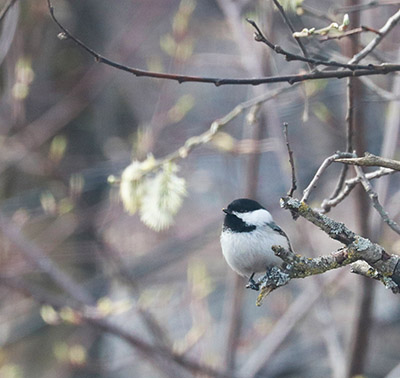
The University of Colorado, through successive studies, has examined the differences between Chickadees across altitudes and snowy environments. They wanted to know: is it harsher winters that makes more adaptive birds? The answer seems to be – yes, but not entirely so. Chickadees with better memory retrieval are indeed consistent with higher altitudes and harsher, colder environments.
A 2002 study which examined Black-capped Chickadees from Alaska and Chickadees in Colorado, determined that the less forgiving winters made the birds more efficient. They did cache more food, were able to recall their caches with greater efficiency, performed more highly on specialized memory tests, and also had larger hippocampi with more neurons than their counterparts elsewhere.
The study, led by Vladimir Pravosudov, subsequently led into other studies, even though the initial concept was considered outlandish at the time. Other studies, spurred by the results, looked at Chickadees in different elevations in the same geographical area of coniferous forest. The results of a 2012 study said, indeed, even in a close geographical area, higher elevation changes also contributed toward these more efficient Chickadees. In fact, a similar species, Mountain Chickadees, had larger hippocampi, similarly to our Alaskan and Coloradian Black-capped Chickadees. Mountain Chickadees at 8,000 feet were outperforming their relatives at 6,200 feet.
Ph.D student Carrie Branch took the tests to the wild. A mountain environment can have variables that are hard to predict, something that Alaskans know very well. By using Radio Frequency Identification (RFID) the team was able to detect and record the identity of each subject through leg bands with miniscule transmitters and receivers attached to feeders. Initial efforts were hampered by black bears, who do love a snack dispenser like a bird feeder, and were able to thwart the research team’s variable solutions to their raids. Once researchers devised a bear-proof system they were able to monitor tests across seasons, which is notoriously difficult to replicate in a field lab.
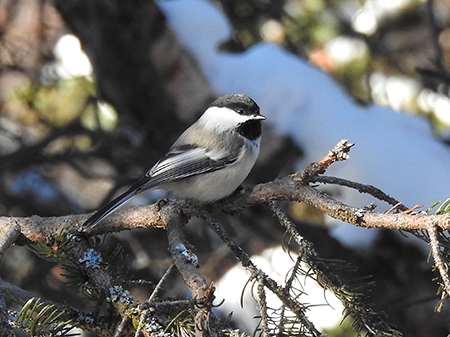
Their work inspired a 2019 study led by PhD student Ben Sonnenberg, and strongly pointed to genetic factors supporting the Black-capped Chickadee’s marvellous cognitive power. Adults had better spatial memory on average than juveniles in their first year, but it was the juveniles who had the better spatial memory to begin with who survived into adulthood. Joining with a team studying genetics through the University of Colorado, they were able to make an awesome discovery: through a series of analyses, they determined a long string of genes that pointed to the Chickadees’ success. These same characteristics show up in humans, chickens, and rodents, and are linked to neuron growth and development, and learning and memory.
So what factor does the environment play? Chickadees that have developed for higher elevations trade being less aggressive and exploratory for their keen intelligence. Birds at a lower elevation are much more territorial, and more able to chase off rivals from higher elevations.
The less forgiving mountain winters have made Chickadees smarter– but not quite in the way that we might have thought. What we can learn from them, in turn, can tell us so much about the environment they inhabit, too.
Now, when I look at Chickadees, I still look at them with fondness – but also with great admiration. These black-and-white icons of our yards and forests are hidden wonders before our very eyes. I now ponder what more secrets they, and other little songbirds, have to share with us.
Tiny Birds with Amazing Memories - Duke research
Mountain Winters Make Chickadees Smarter
Subscribe to be notified about new issues
Receive a monthly notice about new issues and articles.
